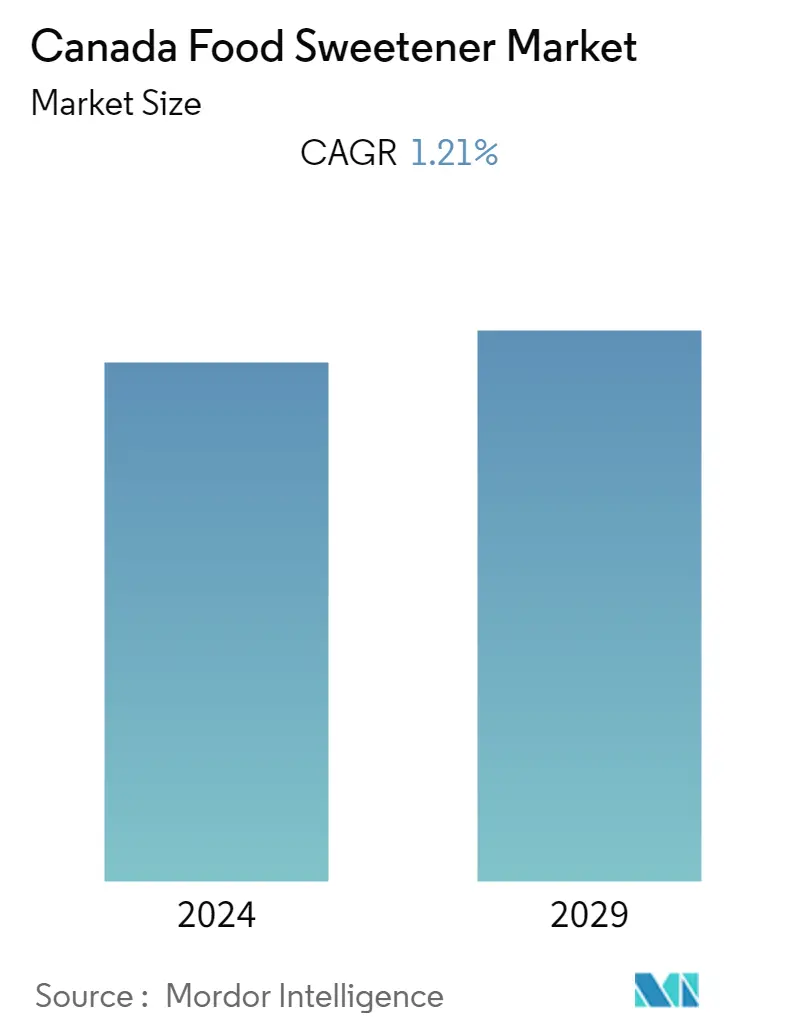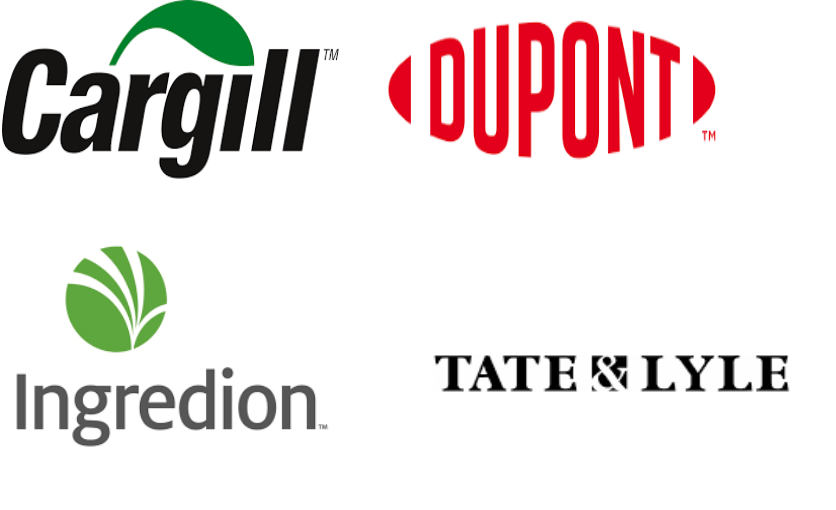Market Size of Canada Food Sweetener Industry

| Study Period | 2019 - 2029 |
| Base Year For Estimation | 2023 |
| Forecast Data Period | 2024 - 2029 |
| Historical Data Period | 2019 - 2022 |
| CAGR | 1.21 % |
| Market Concentration | Low |
Major Players
*Disclaimer: Major Players sorted in no particular order |
Canada Food Sweetener Market Analysis
Canada Food Sweetener Market is growing at a CAGR of 1.21% during the forecast period (2020-2025).
- In Canada, sugar production capability is significantly low. The country has been relying on imports, since the past few decades, despite being a major region in the continent.South American countries are the primary exporters to Canada, and are subjected to related trade disputes.
- The country’s regulatory structure, especially for sugar substitutes, is highly extensive. Furthermore, it covers, both, natural and artificial sweeteners under the Food and Drugs Act and Regulations.
- In Canada, purified stevia extractis regulated as a food additive. It has undergone a full safety review, and was approved for use in various foods sold in Canada. Stevia is not considered safe is various countries, but the Canadian Health added stevia to its list of permitted sweeteners.
Canada Food Sweetener Industry Segmentation
Canada Food Sweetener Market is segmented by Type into Sucrose, Starch Sweeteners and Sugar Alcohols. By Application the market is segmented into Dairy, Bakery, Beverages, Confectionery, Soups, Sauces and Dressings and Others.
| By Product Type | ||||||||||
| Sucrose (Common Sugar) | ||||||||||
| ||||||||||
|
| By Application | |
| Dairy | |
| Bakery | |
| Soups, Sauces and Dressings | |
| Confectionery | |
| Beverages | |
| Others |
Canada Food Sweetener Market Size Summary
The Canada food sweetener market is characterized by a reliance on imports due to limited domestic sugar production capabilities. This dependency has positioned Canada as a significant importer, primarily from South American countries, despite ongoing trade disputes. The regulatory landscape in Canada is comprehensive, particularly concerning sugar substitutes, which are governed under the Food and Drugs Act and Regulations. Both natural and artificial sweeteners, including purified stevia extract, are subject to these regulations. Stevia, despite its controversial status in other countries, has been approved for use in Canada after a thorough safety review. Additionally, maple syrup, a traditional Canadian product, is increasingly used as a sugar alternative in various food applications, although its market share has faced challenges from U.S. competition and internal issues like quota systems and black marketing.
The market for food sweeteners in Canada is fragmented, with numerous large and small players vying for market share through product innovation and portfolio expansion. Companies such as Cargill, Ingredion, Tate & Lyle, and DuPont are prominent in this space, offering a range of sweeteners, including both artificial and natural options like aspartame, sucralose, and xylitol. These sweeteners are widely used in products such as soft drinks, desserts, and breakfast cereals, and are recognized as safe under the Generally Recognized As Safe (GRAS) category by the USDA. The competitive landscape is driven by the demand for natural and clean label products, as well as low-calorie alternatives, reflecting broader consumer trends towards healthier eating habits.
Canada Food Sweetener Market Size - Table of Contents
-
1. MARKET DYNAMICS
-
1.1 Drivers
-
1.2 Restraints
-
1.3 Porter's Five Forces Analysis
-
1.3.1 Bargaining Power of Suppliers
-
1.3.2 Bargaining Power of Buyers
-
1.3.3 Threat of New Entrants
-
1.3.4 Threat of Substitute Products and Services
-
1.3.5 Degree of Competition
-
-
-
2. MARKET SEGMENTATION
-
2.1 By Product Type
-
2.1.1 Sucrose (Common Sugar)
-
2.1.2 Starch Sweeteners and Sugar Alcohols
-
2.1.2.1 Dextrose
-
2.1.2.2 High Fructose Corn Syrup (HFCS)
-
2.1.2.3 Maltodextrin
-
2.1.2.4 Sorbitol
-
2.1.2.5 Xylitol
-
2.1.2.6 Others (Glucose Syrup,Glucose-Fructose syrup, Fructose-glucose syrup, Isoglucose, Fructose, Mannito, Maltitol, Erythritol, Lactitol, Isomalt)
-
-
2.1.3 High Intensity Sweeteners (HIS)
-
2.1.3.1 Sucralose
-
2.1.3.2 Aspartame
-
2.1.3.3 Saccharin
-
2.1.3.4 Cyclamate
-
2.1.3.5 Ace-K
-
2.1.3.6 Neotame
-
2.1.3.7 Stevia
-
2.1.3.8 Others (Glycyrrhizin, Mogroside V , Luo han guo, Thaumatin, Monatin and others)
-
-
-
2.2 By Application
-
2.2.1 Dairy
-
2.2.2 Bakery
-
2.2.3 Soups, Sauces and Dressings
-
2.2.4 Confectionery
-
2.2.5 Beverages
-
2.2.6 Others
-
-
Canada Food Sweetener Market Size FAQs
What is the current Canada Food Sweetener Market size?
The Canada Food Sweetener Market is projected to register a CAGR of 1.21% during the forecast period (2024-2029)
Who are the key players in Canada Food Sweetener Market?
Cargill, Ingredion, Tate & Lyle and DuPont are the major companies operating in the Canada Food Sweetener Market.

